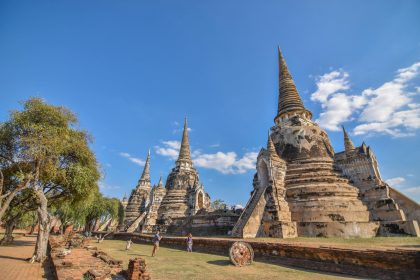Nestled in the vibrant heart of Tokyo, the Imperial Palace is a testament to Japan’s rich history, cultural heritage, and architectural prowess. As the Emperor of Japan’s primary residence, the palace is a symbol of the Japanese monarchy and a striking representation of the country’s resilience, tradition, and modernity. This article delves into the history, significance, and features of the Imperial Palace, exploring why it continues to captivate the hearts of both locals and tourists alike.
A Glimpse into History
The origins of the Imperial Palace can be traced back to the 15th century, at the site of the Edo Castle, which served as the center of power for the Tokugawa shogunate. When the Meiji Restoration occurred in 1868, the emperor moved from Kyoto to Tokyo, making the city the new imperial capital. The Edo Castle was then transformed into the Imperial Palace, which has undergone numerous renovations and reconstructions over the years due to fires and World War II damage.
The current structure of the Imperial Palace blends traditional Japanese architectural styles with modern influences. Despite its historical significance, the palace is not open to the public except for certain areas during special occasions, such as the Emperor’s Birthday and New Year’s celebrations. However, the surrounding gardens and outer grounds provide ample opportunity for visitors to appreciate the beauty and serenity of this iconic location.
Architectural Marvel
The Imperial Palace is a stunning example of traditional Japanese architecture, characterized by its elegant lines, wooden structures, and harmonious integration with nature. The palace grounds cover an impressive 1.15 square kilometers and are surrounded by a moat and stone walls, creating a peaceful oasis amidst the bustling city. The most prominent feature of the palace is the Imperial Palace East Garden, a meticulously maintained landscape that showcases the beauty of Japanese gardens.
The East Garden is what remains of the inner palace area of the Edo Castle. It serves as a public park, open to visitors year-round. Within the garden, you will find remnants of historical structures, such as the foundations of the old castle, traditional tea houses, and carefully curated flower beds that change with the seasons. The cherry blossoms in spring attract countless visitors and photographers, creating a picturesque scene highlighting Japan’s natural beauty.
Cultural Significance
The Imperial Palace is not just an architectural gem but also a cultural and spiritual symbol for the Japanese. The Emperor of Japan, Emperor Naruhito, plays a vital role in Japanese society, serving as a figurehead and representative of the nation. The Imperial Palace serves as the venue for various state ceremonies, including the enthronement of new emperors, weddings, and official receptions.
The rituals and traditions associated with the Imperial Palace are deeply rooted in Shinto beliefs, reflecting the spiritual connection between the emperor and the divine. The palace grounds house several Shinto shrines, including the famous Kōkyo Gaien National Garden, where the spirits of past emperors are honored. These cultural practices underscore the palace’s importance in preserving Japan’s heritage and fostering a sense of national identity.
Accessibility and Visitor Experience
While the interior of the Imperial Palace is not accessible to the general public, visitors can still enjoy the surrounding areas. The East Garden is a must-visit, offering a serene escape from the hustle and bustle of Tokyo. The garden features walking paths, ponds, and seasonal flora, making it a perfect spot for strolls and picnics.
In addition to the East Garden, guided tours of the Imperial Palace’s outer grounds are available, providing visitors with insights into the site’s history and significance. The tours typically include visits to the Imperial Palace East Garden, the main gate, and the beautiful stone walls that have stood the test of time. For those interested in Japanese history and culture, these tours offer a unique opportunity to learn more about the imperial lineage and its impact on Japan.
Special Events and Celebrations
The Imperial Palace is a hub of activity during several key events throughout the year. One of the most significant occasions is the New Year’s Greeting when the Emperor and his family appear on the palace balcony to greet well-wishers. Thousands of people gather to celebrate the new year and receive blessings from the imperial family, creating a festive atmosphere filled with joy and hope.
Another notable event is the Emperor’s Birthday, celebrated on February 23. On this day, the palace opens its gates to the public, allowing thousands of visitors to enter the grounds and extend their best wishes to the Emperor. The imperial family standing before the crowd, waving and smiling, is a heartwarming experience that underscores the deep connection between the monarchy and the people.
The Imperial Palace in Modern Context
As Tokyo evolves into a modern metropolis, the Imperial Palace remains a constant reminder of Japan’s rich history and cultural identity. Skyscrapers and bustling streets surround the palace grounds, juxtaposing ancient traditions with contemporary life. This harmonious coexistence illustrates Japan’s ability to preserve its heritage while embracing modernity.
The palace also plays a role in international diplomacy, hosting state visits and meetings with foreign dignitaries. The Emperor’s ceremonial duties foster goodwill and strengthen international relations, further solidifying the palace’s significance beyond Japan’s borders.
Conclusion
The Imperial Palace in Tokyo is more than just a historical site; it is a living symbol of Japan’s enduring spirit, cultural heritage, and national identity. From its architectural beauty to its cultural significance, the palace inspires and captivates all who visit. As a timeless jewel in the heart of Japan’s capital, the Imperial Palace invites exploration and reflection, reminding us of the importance of preserving our history while embracing the future.
Whether you are a history enthusiast, a nature lover, or simply seeking a peaceful retreat from the urban chaos, the Imperial Palace offers an unforgettable experience. As you wander through its gardens and admire its architecture, you are transported to a world where tradition and modernity coexist, echoing the essence of Japan itself. A visit to the Imperial Palace is not just a journey through time; it is an opportunity to connect with the heart and soul of Japan, an experience that lingers long after you leave its tranquil grounds.



